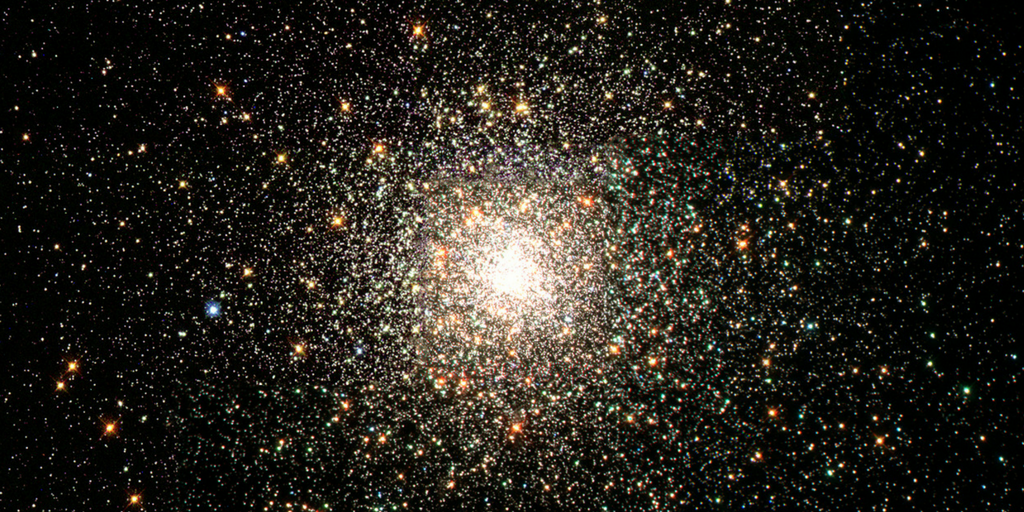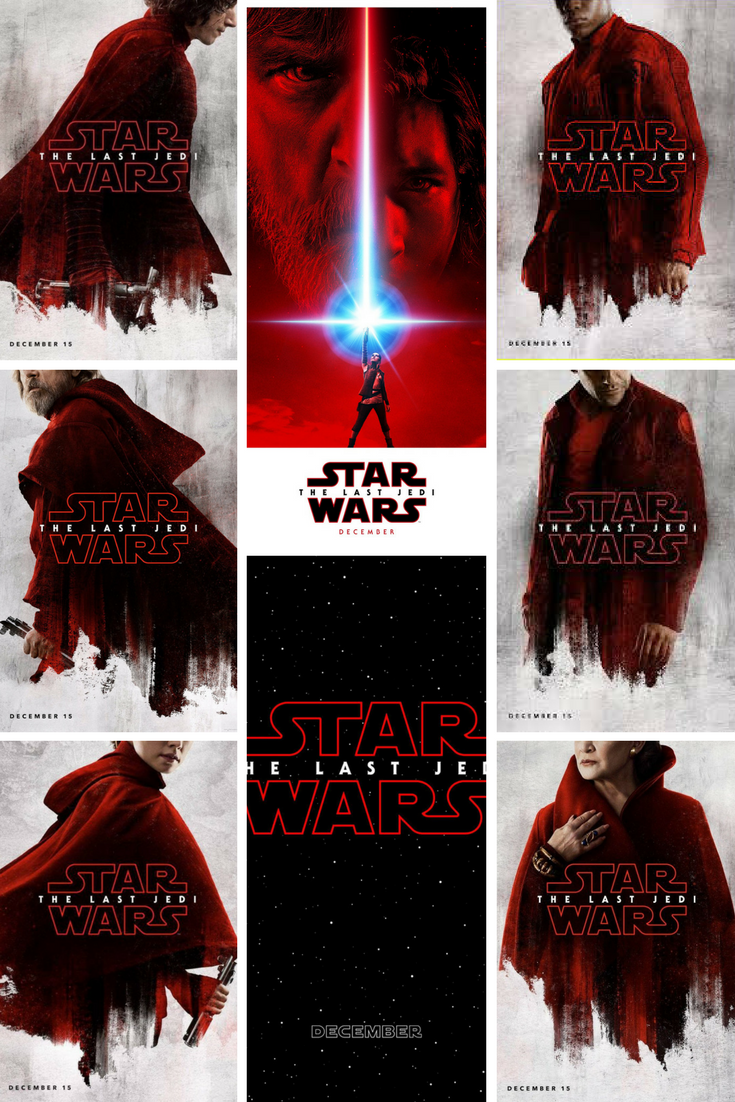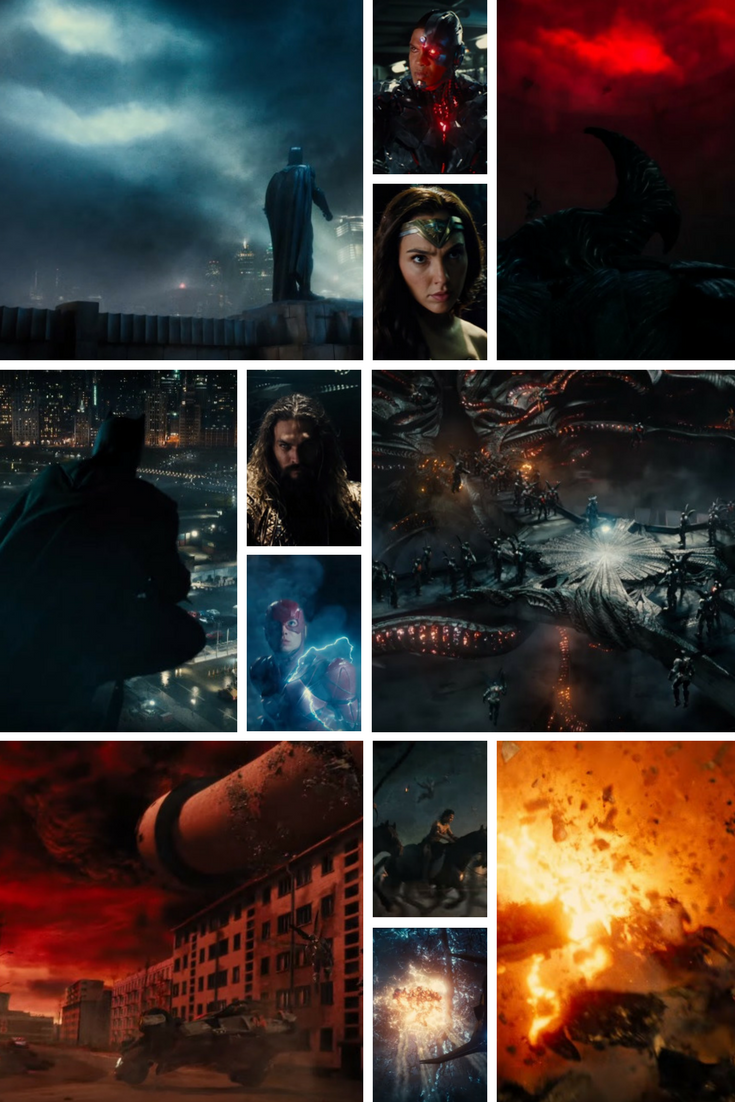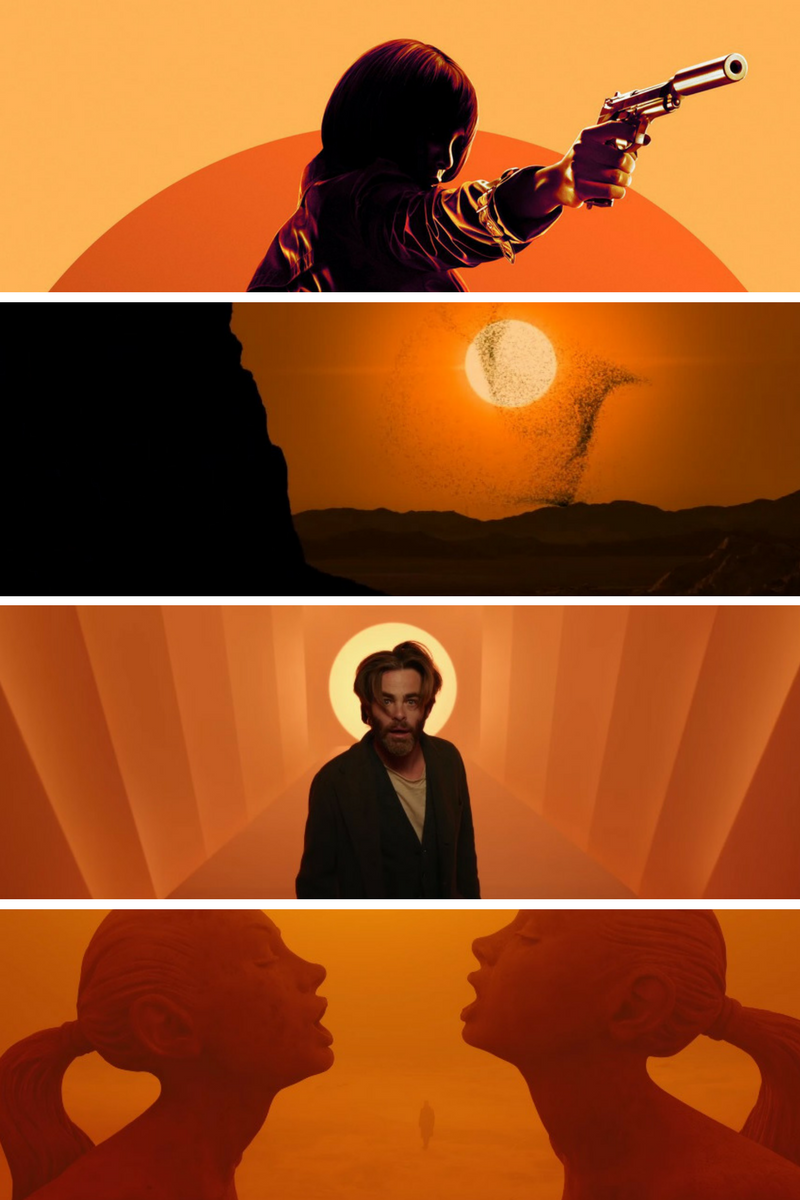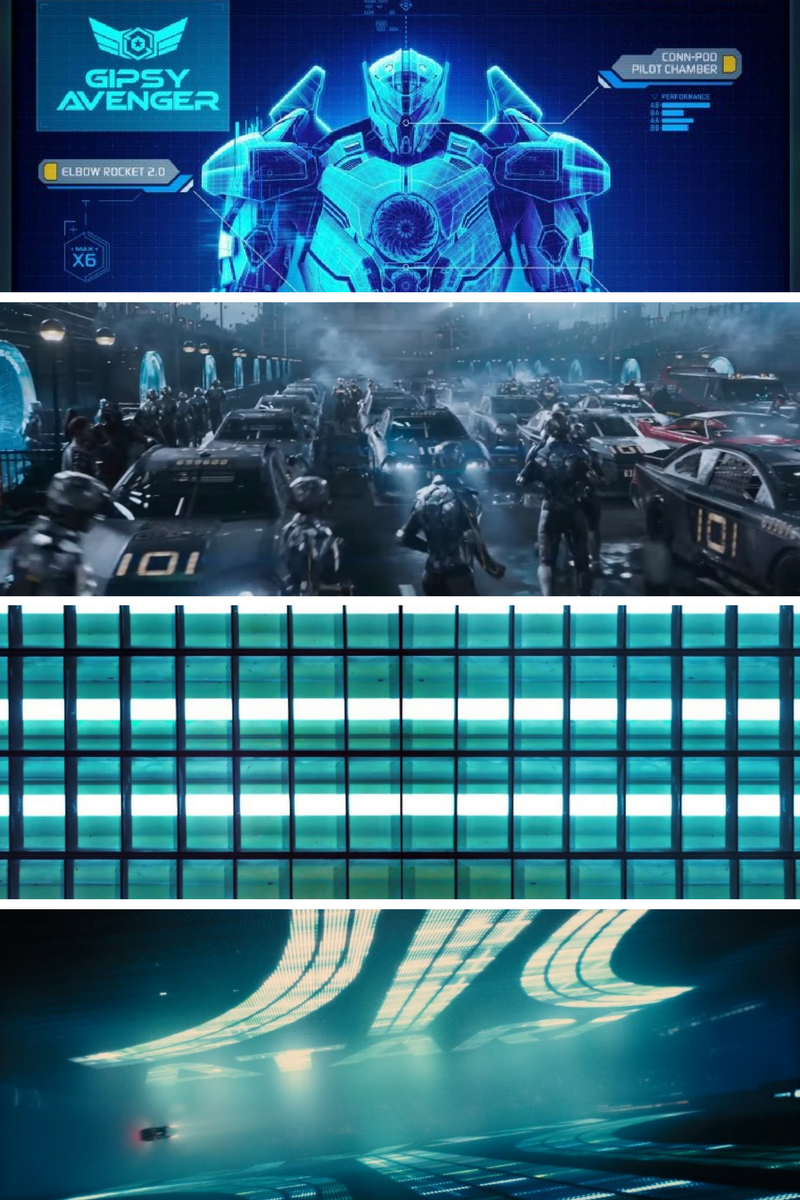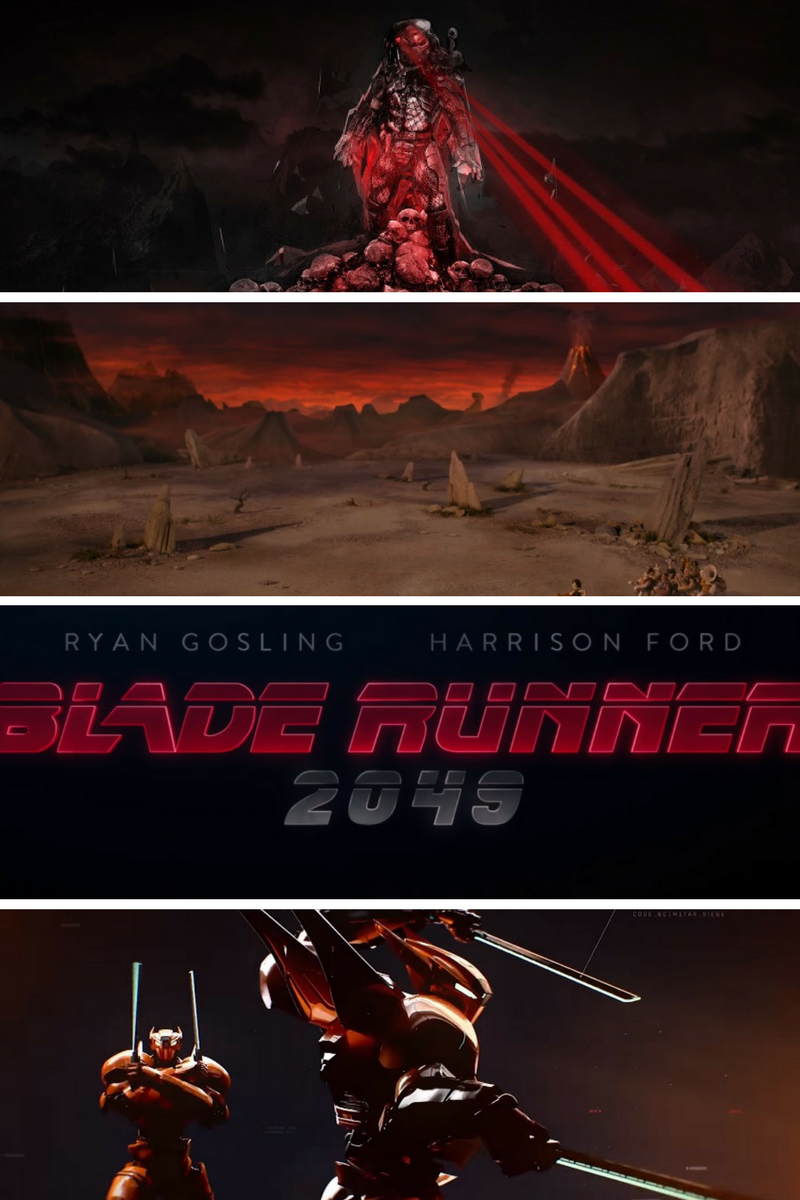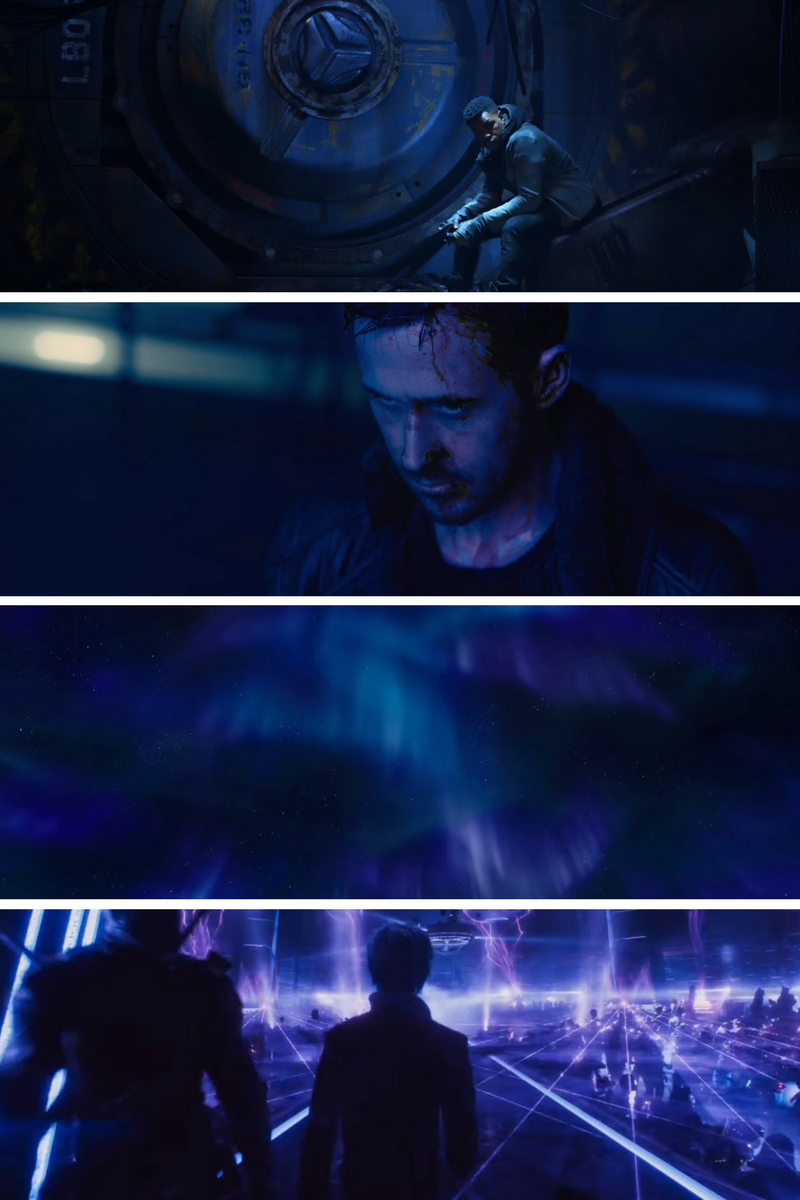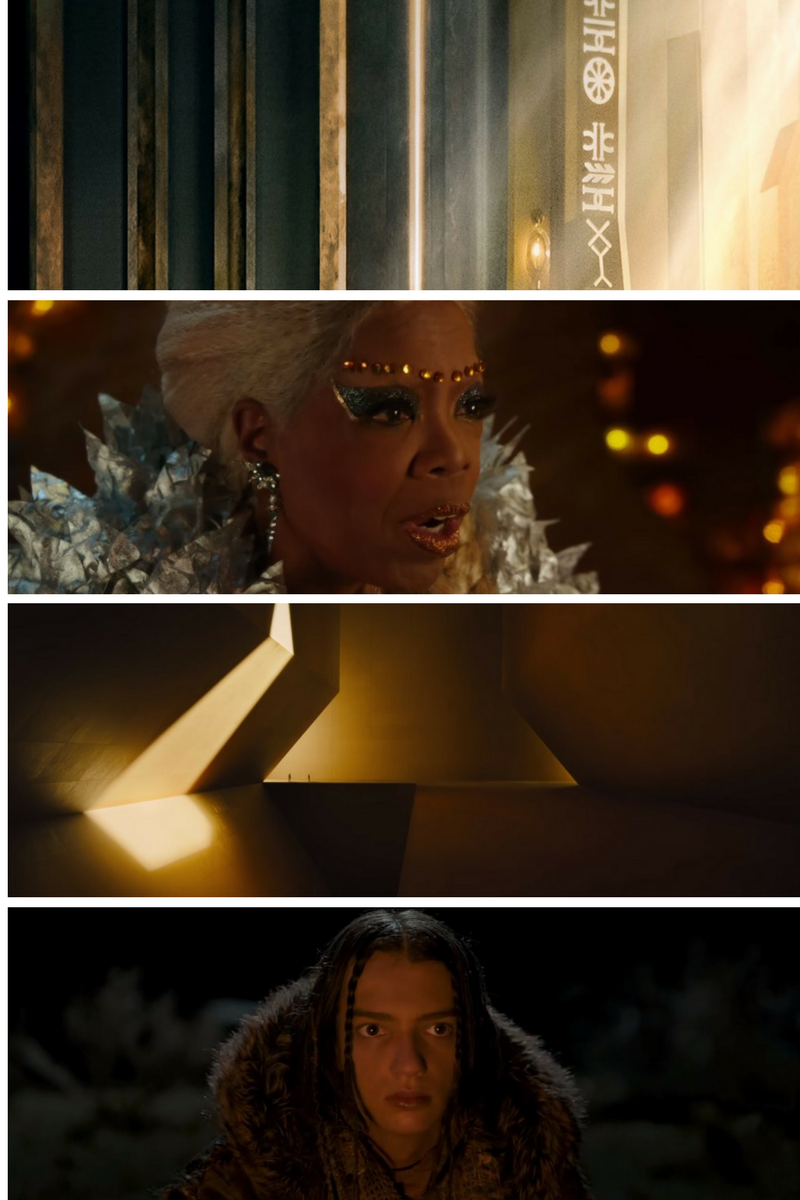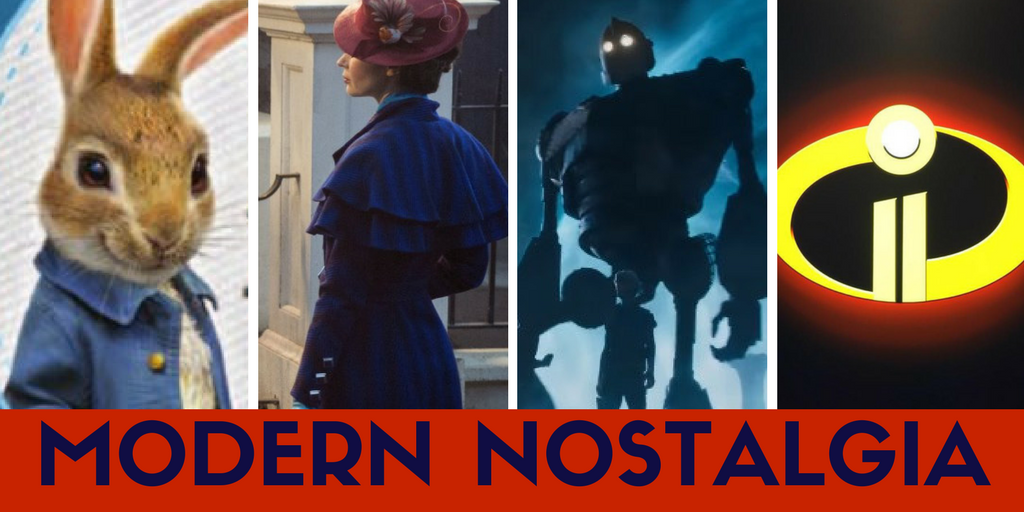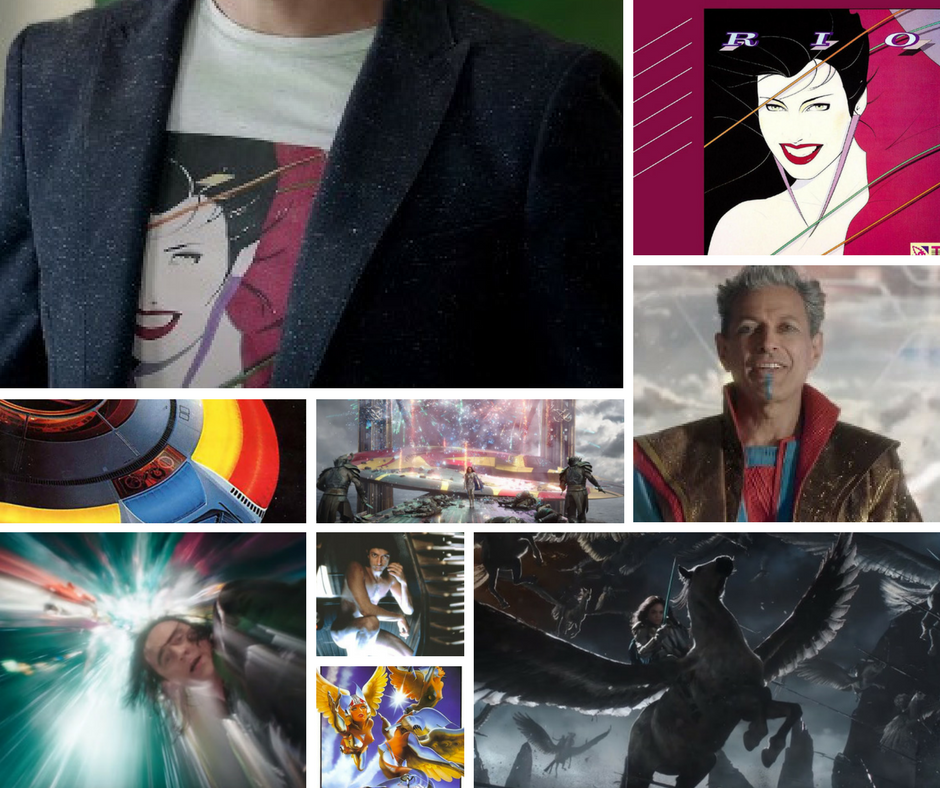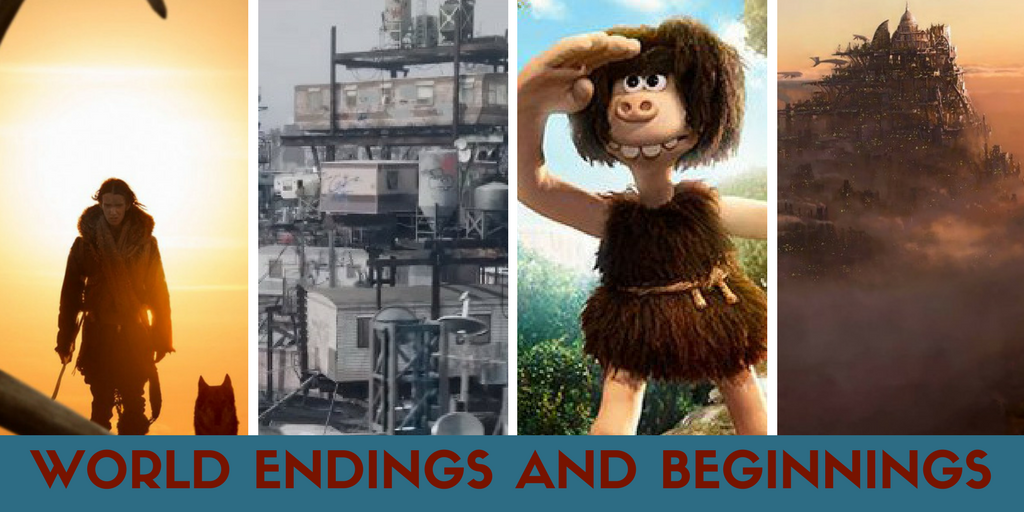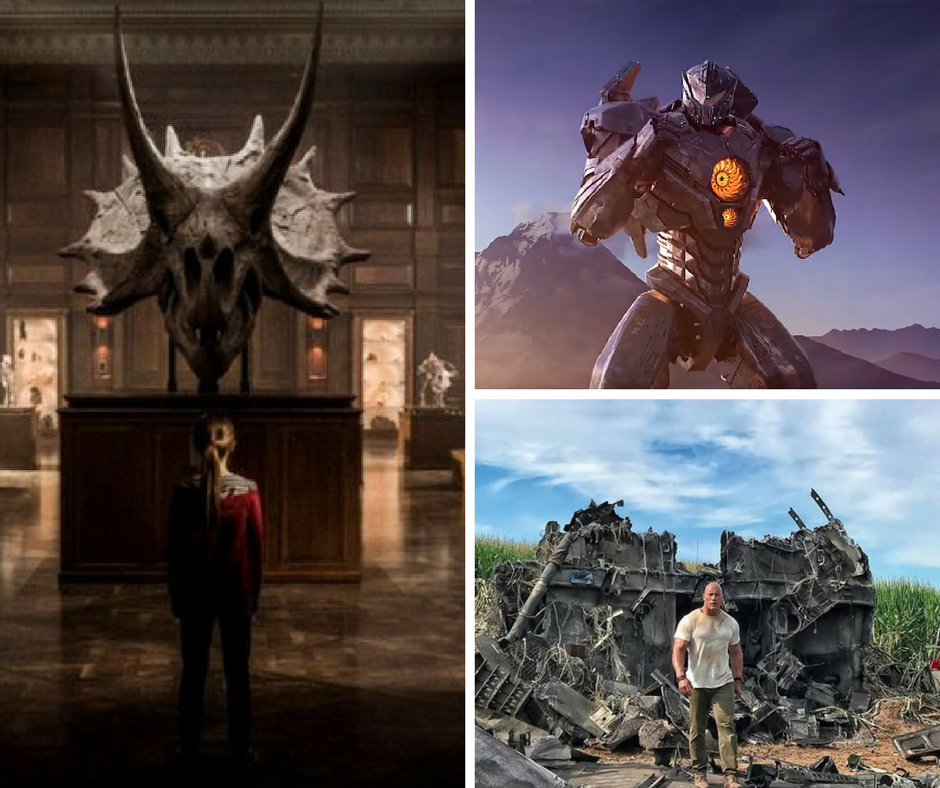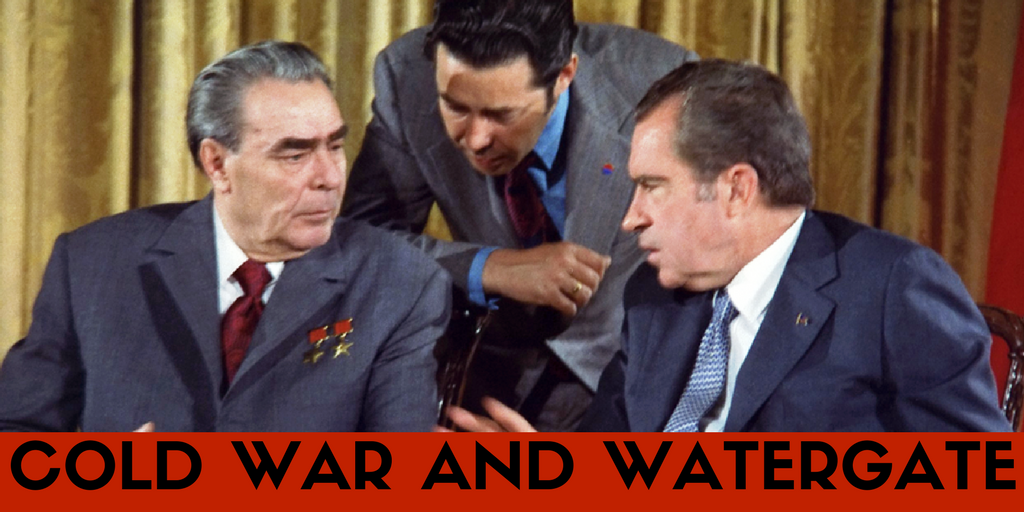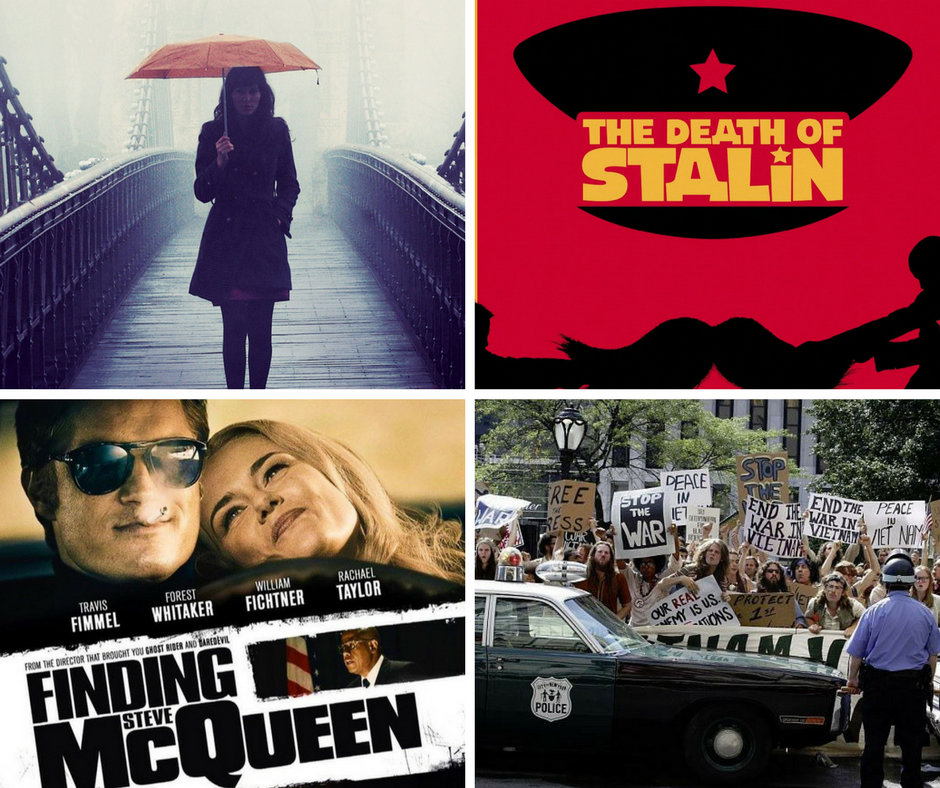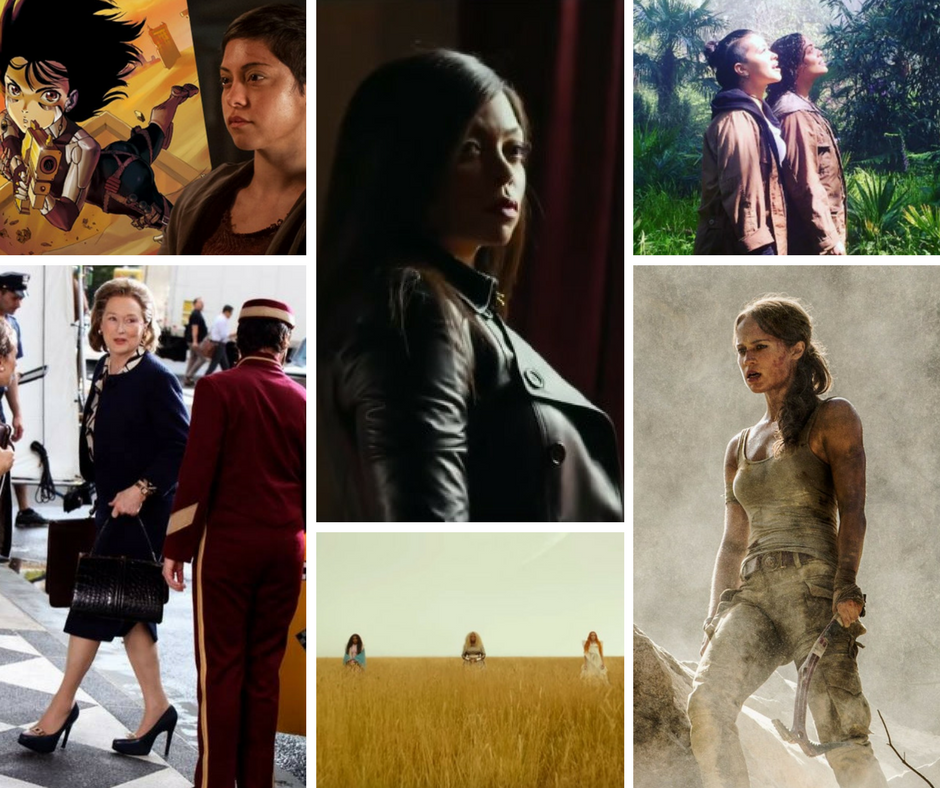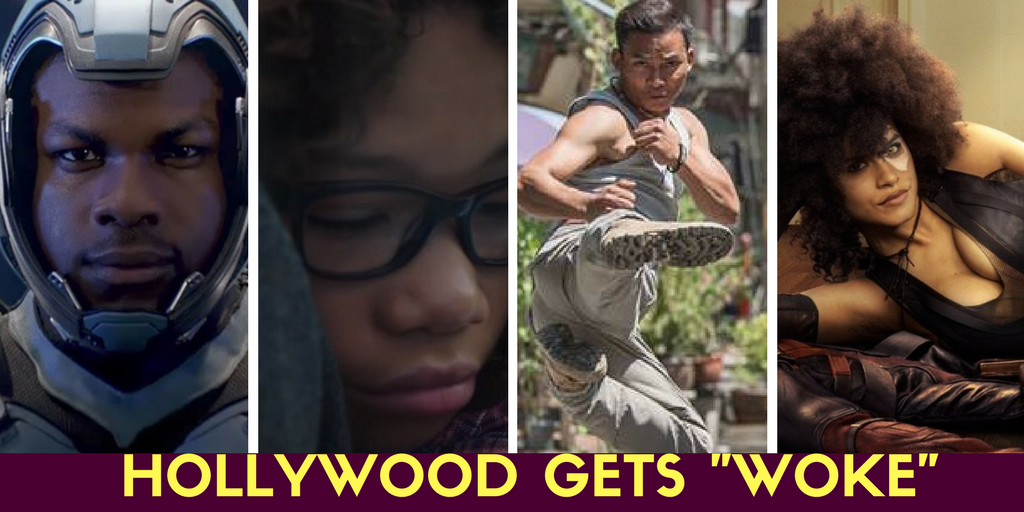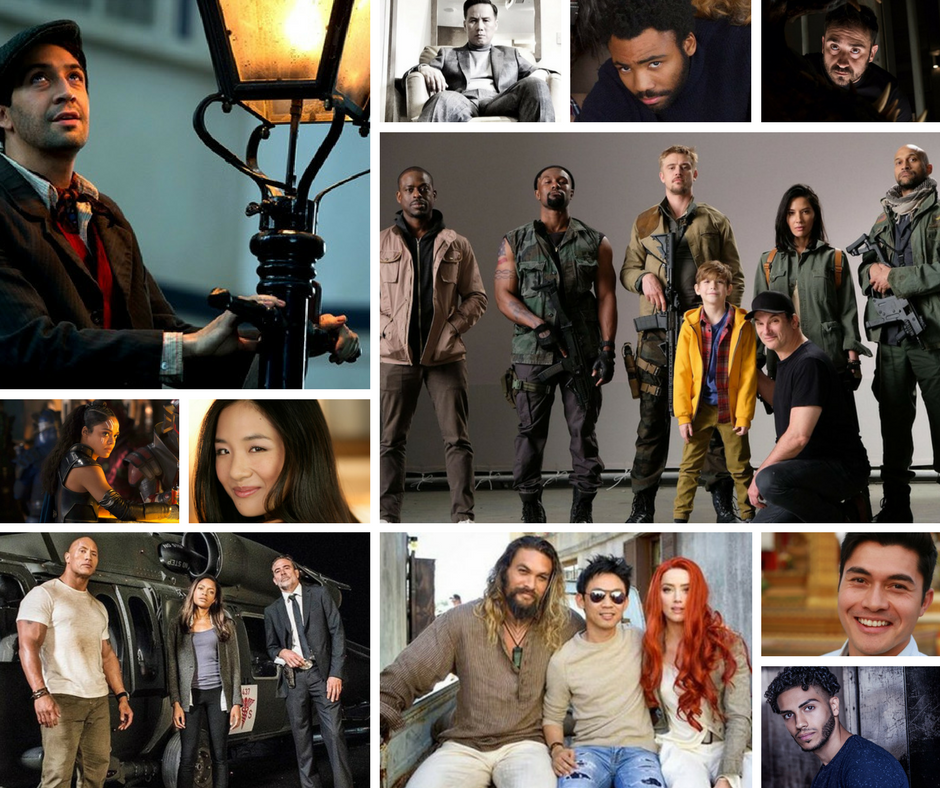It’s time to look to the near future of film. Just like how the fashion industry has become an industry that relies on trend forecasting, let’s utilize the same concept when discussing what kind of mood the country will be in when we decide to sit in the theaters next year. From where I’m sitting, 2018 is going to be a year of contemplation, a year of gathering one’s bearings after a tumultuous 2017, and overall, a year of figuring out where we in the U.S. and, indeed, the world, are going if we keep on our path towards destruction.
COLOR STORY
The color story that seems to be going on in 2018 is muted blues and black disrupted by explosive, fiery colors–dark red, orange, and gold. My using the word “explosive” is meant in both a descriptive and literal sense; there is a very real sense of literal explosions in our daily life at this point in 2017, what with the threat of North Korea, the growing Cold War-esque tensions between the U.S. and Russia, and the country’s own political explosions with mounting evidence that showcases President Trump and the administration under the sway of Russian Prime Minister Vladimir Putin’s power.
The end of 2017 will see dark red come into play as we transition from this year into the next. Check out these Star Wars: The Last Jedi posters from this year:
Dark red is the dominant color, painting each of the characters to show that no matter what side you’re on, everyone’s going to be affected politically, socially, and personally by the upheaval that will happen in this next part of the saga.
All of this year’s colors are featured in The Justice League, which is coming out late 2017. The Zack Snyder-led DCU has been consistently moody, with blues, reds, oranges, and blacks making up the color palette. Perhaps it’s because of this big tentpole that we’ll see a lot more films take on a more Snyder-esque palette for their promotional material. What’s funny is that as much as people have derided Snyder for his bleak palette, 2018 will be the year that we as a culture actually feel it reflected in our collective mood. Maybe Snyder was onto something the whole time.
Red, gold, orange, neon blue and muted blues make their way into several of next year’s movies, both in their posters and in the trailers themselves. The throughline seems to be that humanity wants to find the balance between war and peace, technology and human experiences, existentialism and optimism. The importance of neon blue definitely shows itself in the more futuristic films; in these films, humanity on the precipice of extinction–or at the very least, fighting for some kind of co-existence with a more dominant species– is the main plot point.
ORANGE: Power, the unknown, disturbance
(featured: Proud Mary, Alpha, A Wrinkle in Time, Blade Runner: 2049)
NEON BLUE: Technology, mechanical coldness, human advancement (not always for the better)
(featured: Pacific Rim: Uprising, Ready Player One, Black Panther, Blade Runner: 2049)
RED AND BLACK: Ominous threat, fright, fight for survival
(featured: The Predator, Early Man, Blade Runner: 2049, Pacific Rim: Uprising)
NAVY AND MUTED BLUES: Contemplation, the dark side of technology, lurking threat, existentialism
(featured: Pacific Rim: Uprising, Blade Runner 2049, A Wrinkle in Time, Ready Player One)
GOLD AND BLACK: Personal strength, inner power, intelligence, new beginnings
(featured: Black Panther, A Wrinkle in Time, Blade Runner 2049, Alpha)
2018 MAJOR THEMES
Movie studios will still be making reboots, remakes, and sequels. However there seems to be an even clearer note of nostalgia with some of these films in 2018 aside from Hollywood trying their luck with any book or older film property.
Nostalgia, particularly nostalgia for the ’80s and ’90s (a time when a big chunk of the most catered to media demographic, young people 18-40, were kids or teenagers) will be apparent in 2018. Of course, Blade Runner: 2049 is a big send-up to the ’80s, but there’s also Ready Player One, which will have properties that span the ’80s and ’90s making cameo appearances (such as The Iron Giant, featured above). Other films such as Goosebumps: Horrorland, The Predator, and Jurassic World: Fallen Kingdom keep up the nostalgic ’80s and ’90s trend. Even horror is getting on the bandwagon with the resurgence of killer doll Chucky and Halloween‘s Mike Myers.
Other films, like Barbie, Peter Rabbit, S.C.O.O.B. (a new live-action iteration of Scooby-Doo) and Mary Poppins Returns show that childhood memories from any era are back in play. Overall, the nostalgic trend showcases the longing everyone has to go back to a time when they didn’t have to worry about the fate of the world every. single. day.
A big example of the ’80s trend in mainstream tentpoles is Thor Ragnarok.
Thor isn’t a legacy property the same way Barbie, Peter Rabbit, and Mary Poppins are. But, as was apparent in Guardians of the Galaxy Vol. 2, the late ’70s and ’80s are a big influence on Marvel’s intergalactic adventures. I mean, it’s not accident that Bruce Banner shows up wearing a shirt featuring Duran Duran’s RIO album cover, or that ’80s genre it boy Jeff Goldblum is part of the main cast. The bright colors, bombastic feel, and Valkyrie showing up with a fleet of warriors on winged horses smacks of 1970s and 1980s heavy metal, Philip Castle airbrush art, as well as 1980s candy-coated cartoons, which also delved into their share of metal inspiration via He-Man, She-Ra, and ThunderCats. Even the ship that is felled by the fireworks display behind Valkyrie (below) seems to pay homage to the spaceship iconography apparent with the band Electronic Light Orchestra, aka ELO.
(featured: scenes from Thor: Ragnaork, Jeff Goldblum in The Fly, Philip Castle airbrush artwork, ELO spaceship artwork)
In short, film studios want those of us in our 20s and 30s to feel like we did when we’d stay up to watch TGIF or when woke up early to watch Saturday morning cartoons. That feeling of nostalgia is going to be used as a buffer and distraction from the scary times we have yet to enter come 2018.
While we’re all pining for our worry-free childhoods, we’ll also be taking stock of our place in the universe and whether we can keep our planet going for another couple thousand years. Quite a few films will focus on the world at its bleakest and most depleted as well as the world when it was fresh and new. Alpha, starring Kodi Smit-McPhee, is set during the last part of the Ice Age, and Aardman’s Early Man will have its protagonist, a Bronze Age man (voiced by Eddie Redmayne), on a journey to save his beloved city.
On the extinction side of things, Ready Player One takes place in a near future in which Detroit is inundated with trailer-home skyscrapers called The Stacks and Mortal Engines, based on the popular book series by Philip Reeve, shows an earth that is desolate after the “Sixty Minute War,” with cities roaming Laputa-style, attacking and eating smaller cities in its path to replenish supplies. Extinction, which will feature Michael Peña, Mike Colter, and Lizzy Caplan, will see our current world invaded by aliens.
Sci-fi in 2018 will be almost exclusively about the world’s dire straits and how we humans can protect ourselves and the world from becoming extinct. One of Dwayne Johnson’s many projects next year, Rampage, is based on an ’80s video game (yes, nostalgia again), but it’ll be a more serious take on the game, which involved monsters wreaking havoc on cities. In the film, the monsters are animals (endangered or vulnerable animals, no less) that have been mutated by a mad scientist to destroy humanity. Pacific Rim: Uprising continues the story of a world that is constantly at war with underwater aliens, and Jurassic World: Fallen Kingdom takes the dinosaurs out of the park and into the metropolis, creating yet another version of Godzilla. (Also, don’t forget about the sequel to Godzilla, coming in 2019, which will continue the environmentally-conscious trend in sci-fi films).
So why do sci-fi films seem to have a lot of power when it comes to this environmental message? Well, one of the cornerstones of sci-fi film is to discuss our culpability in our own demise and whether we’ll have the smarts to right our wrongs. And while we’ve been fantasizing about aliens wiping us out, the real threat has been us all along–we’ve mutated as many animals and destroyed as much wildlife as any alien in sci-fi has. So the alien threat in most of these films has become nature itself. When there is actual science to back up your sci-fi–yes, the earth is heating up and we’re destroying the ecosystem at all levels and perhaps we’re making our own grave if we don’t invest in sustainable methods of living–then sci-fi’s environmental message becomes that much stronger.
(featured: Jurassic World: Fallen Kingdom, Pacific Rim: Uprising, Rampage)
It’s a little early, but I’ve been looking at the 2019 slate as it stands right now, and it would seem that some more optimistic films are on the horizon after 2018. Perhaps the film industry is banking on us getting out of our present political and social state (we will be getting closer to Trump’s end of his first–and hopefully final–term) and we’ll finally have reason to celebrate. Let’s hope so. But in 2018, we’ll be in the existentialist thick of figuring out how we’re going to keep this world spinning.
We’re at odds with Russia, and more and more people believe that the Russian government has injected itself into our politics and in the country’s presidency. More insidious is the probability that Trump is willingly under Putin’s thumb. We haven’t faced such times as these since President Nixon’s Watergate scandal and the Cold War, which lasted from the lasted from the late ’40s to the ’80s (again, there’s a hint of ’80s nostalgia there). So naturally, 2018 will see an increased focus on ’70s and ’80s politics, the Cold War, Nixon and Watergate, and new interpretations of those themes in present-day stories. Films such as Red Sparrow and Finding Steve McQueen are directly related to Russian/American politics, both in the 1970s and today. The interest in Russia has already in TV, with Channing Tatum’s Comrade Detective and HBO’s Fahrenheit 451 (I’ll get to TV in another post, so don’t worry, I’ll get to the TV trends too). That trend is also already coming to film with this September’s The Death of Stalin, chronicling the days after the Joseph Stalin’s death.
(featured: Red Sparrow book cover, The Death of Stalin, Finding Steve McQueen, The papers set photo)
The Papers is another film that’s about the 1970s (and late 1960s), but it’s handling public distrust of another kind. The Papers is all about the discovery of The Pentagon Papers, which showed that President Johnson lied to the public about the nature of the Vietnam War. While this isn’t directly about Nixon or Watergate, it’s still showing that the film tide is turning towards investigating a lack of trust in authority, particularly in a “post-truth” society.
Eventually, the focus that is beginning to be applied to Russia and the Cold War of the ’80s will also rope in North Korea as well. With North Korea becoming more and more of a nuclear threat each day, screenwriters will no doubt want to turn their attention towards the Hermit Kingdom, and studios will also probably want to capitalize on some of the properties that are already out that focus on nuclear threat. (A possible resurgence of Watchmen, perhaps? Just spit-balling here).
As you can see in this Oceans Eight first look image, women are going to be in power in all kinds of ways. From robbing folks to executing hits to owning stardom, women in unconventional and/or powerful roles will be all over 2018. Some of the films we’ll see next year are Battle Angel Alita, A Wrinkle in Time, Mary Poppins Returns, Mamma Mia: Here We Go Again!, The Nightingale, Red Sparrow, Tomb Raider, Crazy Rich Asians, Proud Mary, Widows, Ant Man and the Wasp, Life of the Party, The Papers, Winchester, The Girl in the Spider’s Web, Annihilation, X-Men: Dark Phoenix, and The Nutcracker and the Four Realms, to name a few.
(featured: Rosa Salazar cast in Alita: Battle Angel, Meryl Streep in The Papers, Taraji P. Henson in Proud Mary, Mindy Kaling, Oprah Winfrey and Reese Witherspoon in A Wrinkle in Time, Gina Rodriguez and Tessa Thompson in Annihilation, Alicia Vikander in Tomb Raider)
Several of the films mentioned have women of color at the forefront, and two such films, like Widows and Proud Mary have black women (Viola Davis and Taraji P. Henson, respectively) taking on roles that require their characters to exact deadly revenge, a micro-trend by itself. Alita: Battle Angel, based on a popular anime and manga about a cyborg brought back to life, stars Rosa Salazar amid a multicultural cast, and Crazy Rich Asians finally ends the drought of a lack of a pan-Asian presence on screen. Zazie Beetz (seen below) will become the first lady of Fox’s Deadpool franchise and, of course, all of that is rounded out by the introduction of Storm Reid in A Wrinkle in Time and the big screen debut of ballerina (or as I like to think of her, my ballerina Barbie come to life) Misty Copeland in The Nutcracker and the Four Realms. (As a huge Nutcracker fan, I can’t wait to see the film’s costumes. Here’s hoping they live up to my expectations.)
The tide has been turning for women in film, what with the outcry of several actresses about the lack of meaningful roles for women, the financial gain studios have seen from hiring women for action and bawdy comedy roles (such as Girls Trip, which became the highest-grossing live-action comedy in 2017), and movie-goers’ own demand for actresses getting equal treatment next to their male counterparts. This has led to the portrayal of women who aren’t just boobs and butts with mouths for male pleasure; Alicia Vikander’s Tomb Raider isn’t the busty woman of the past (who still kicked butt, by the way); she’s now a slimmed-down, more athletic-built woman who is on an existential search for herself as well as she finds out the truth about her father. Meryl Streep plays a newspaper titan who is out to get those Pentagon Papers. Gina Rodriguez and Tessa Thompson are scientists studying another world, with no men in sight.
But, as you can probably infer from the high gross from Girls Trip, that there’s also a racial element at play, too. It’s not just that women as a whole are getting more roles, it’s that there’s slowly more equity for women of color to be seated at the table as well. While women in general don’t have as much play as actors, white women still had the lion’s share of the roles. Technically, they still do, but thankfully, with directors of color like Ava DuVernay and actresses of color-turned-producers like Queen Latifah taking the reins, we’re finally beginning to see films starring actresses of color play in roles that were strictly relegated only to white actresses. Would we have seen Mindy Kaling and Oprah play interdimensional beings if it weren’t for another woman of color like DuVernay? I’m sure someone would have done it, but it wouldn’t have happened so soon, I’d think, and it might not have been done with the same intention of equity. Ditto for A Wrinkle in Time featuring an interracial relationship and what looks like a blended family (from the trailers, it’s seems like Storm’s character has a white brother, leading me to think that it’s her stepbrother).
Is Hollywood really “woke” by including more people of color and more of an LGBT focus in its movies? Let’s just say this is Hollywood’s first dip of its big toe in the water of being “woke.” However, this is still a huge push forward in 2018, with a bigger number of films showcasing either all-POC or mostly POC casts.
Of course, there’s Black Panther, Crazy Rich Asians and A Wrinkle in Time, but there’s also, Triple Threat, starring Tony Jaa, Michael Jai White, Tiger Chen and Uko Uwais, and The Predator, which stars Keegan-Michael Key, Sterling K. Brown, Trevante Rhodes, Olivia Munn and Edward James Olmos.
As mentioned before, Annihilation stars Gina Rodriguez and Tessa Thompson, and several movies, including Deadpool 2, Pacific Rim: Uprising, Skyscraper, Gringo, Creed 2, Mary Poppins Returns, the currently-untitled Han Solo Star Wars film, The Alchemist, Aladdin and Jurassic Park: Fallen Kingdom will prominently feature POC characters. Just take a look at this compilation of actors:
(Featured: Lin-Manuel Miranda in Mary Poppins Returns, Tessa Thompson in Thor: Ragnarok, the cast of Rampage, Jurassic World: Fallen Kingdom‘s B.D. Wong, Star Wars Han Solo film’s Donald Glover, J.A. Bayona in Jurassic Park: Fallen Kingdom, the cast of The Predator, the cast of Aquaman and director James Wan, Crazy Rich Asians‘ Henry Golding, Aladdin‘s Mena Massoud)
It also doesn’t hurt that there will be some big films directed by directors of color. DuVernay has been mentioned, and James Wan is in charge of Aquaman. Taika Waititi is behind Thor: Ragnarok and Steve McQueen is behind Widows. Jon M. Chu is bringing his directorial vision to Crazy Rich Asians.
There’s also Simon vs. the Homo-Sapien Agenda, which will be the live-action adaptation of a novel focusing on a high schooler taking coming out to his classmates in his own hands.
With all of this progress, there are still some indications Hollywood isn’t as woke as it’d like to be: at least two of the movies on the current slate feature Asian themes (specifically Japanese storytelling) without Japanese characters. As mentioned already, the Alita film adaptation will feature a multicultural cast with a non-Japanese POC lead, and Isle of Dogs will feature a mostly-white, if not all-white, cast (including Scarlett Johansson, whom people still haven’t forgiven for her role in Ghost in the Shell). We’ll see how these films are handled as we get closer to their releases. Also, Simon vs. the Homo-Sapien Agenda is currently the only high-profile film focusing on a gay character. We’ll see exactly how many LGBT characters and stories are a part of 2018, but it looks like Hollywood is, once again, lacking in this area. There’s also no clear word on how disabled people will be represented either. Seeing how disabled people have been represented this year, there’s no reason to think that 2018 will showcase anything different. But we can hope.
Of course, I haven’t mentioned every film coming out in 2018 (partially because not every film has released its promotional info) and, like with anything, there will be outliers that are hard to put into any category. But these are my general thoughts on 2018–an overview, if you will. What do you think 2018 holds for us? Give your thoughts below!
